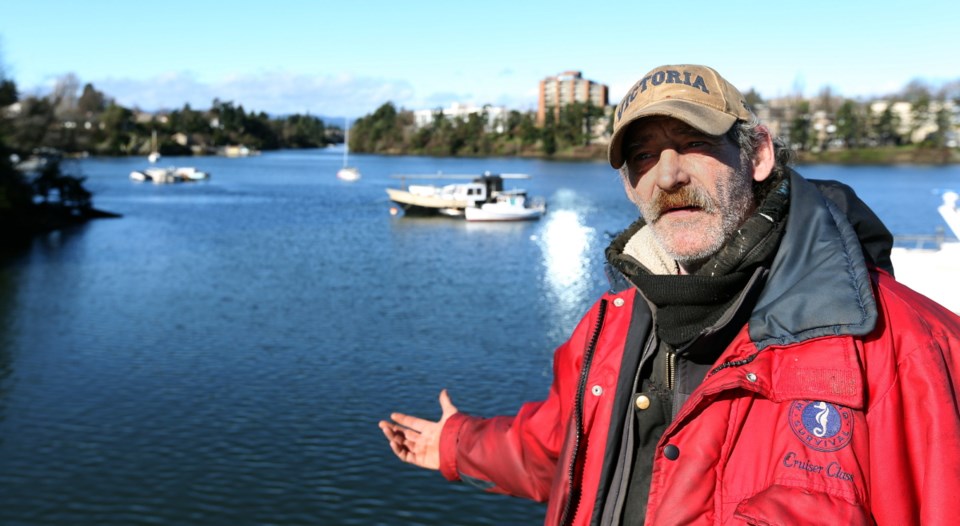Victoria Mayor Lisa Helps has unveiled the city’s plans to rid the Gorge Waterway of derelict and abandoned vessels.
The city hopes to clear the Gorge Waterway of floating wharves and vessels by September, but it requires changes to zoning regulations.
Helps revealed the plan to about 100 people during a public meeting in Vic West on Friday. Many of them said they supported the plan. But Mike Taylor, who said he has three boats in the area, was not impressed.
“We are not the enemy here,” said Taylor, adding the concerns of cyclists and kayakers have superseded the rights of people trying to eke out an existence on the water. “We are being targeted.”
The city says there are four anchored wharves, 22 vessels and 12 small crafts anchored in the Gorge Waterway, about eight of which are inhabited. In addition, there are submerged and sunken vessels.
Critics say the boats are unsightly and unseaworthy and pollute the waterway with raw sewage, garbage, fuel and lubricants. They also complain about noise and obstruction of the waterway.
Rower Frank Rudge said recreational users and environmental groups do their part to keep the local water clean, but a few “bad apples” create obstruction and unsightly mess for everyone else. A high school rowing coach, Rudge said his students are required to do a swim test in the Gorge about 200 metres south of liveaboard boats that dump raw sewage into the water.
The changes proposed by the city aim to prohibit liveaboard use and the storage or abandonment of vessels. Over a near-two-year process, the city initially aimed to prohibit all anchoring in the Gorge Waterway northwest of the Selkirk Trestle to about the Gorge Road Hospital.
However, a recent B.C. Court of Appeal decision regarding anchoring in West Kelowna suggested a blanket prohibition would exceed municipal jurisdiction. The federal government has jurisdiction over navigation.
On Feb. 18, city council will consider staff recommendations (PDF) to initiate a rezoning process to amend the current Gorge Waterway regulations.
The changes would allow for short-term anchoring of up to 48 hours, to a maximum of 72 hours in a 30-day period. The number of boats that could moor overnight has yet to be determined.
If the recommendations are approved, public consultation is planned, including a community meeting in March, the city said. Based on that input, the city would prepare a draft bylaw to implement the zoning regulation changes, after which more public input would be sought.
At Friday’s meeting, resident Craig Bremner said didn’t want to see people living on the water “dehumanized,” but he praised the city for attempting to clean up sewage and debris.
If the proposed regulations are implemented by council, boat owners would be alerted of the changes via signs in May.
In June and July, notices would be posted on boats and floating wharves requesting their removal. Legal action against stragglers would begin in late summer and September, with injunctions used to remove any remaining vessels or structures.
The city says enforcement costs aren’t clear and depend on compliance. Legal costs as well as possible removal costs could amount to more than $100,000.
A portion of the Gorge waterway falls within Saanich’s border. Amendments to its regulations made in 2015 prohibit float homes or vessels and also anchoring for a continuous period exceeding 72 hours.
A portion of the Gorge waterway also extends into Esquimalt, which prohibits boat moorage, although zoning regulations are being reviewed in light of the B.C. Court of Appeal judgment.
On Monday, Saanich Coun. Judy Brownoff will tackle the larger problem of derelict and abandoned vessels for all coastal communities in hopes of pushing the new federal Liberal government to act.
The first motion is to establish funding through fees from vessel purchases, registration, insurance and moorage, for example, to fund an “abandoned and derelict vessel program” as recommended in a 2012 Transport Canada study.
The second motion would establish an end of life vessel disposal program to plan for vessels coming to the end of their lifespan. A 2012 Transport Canada study that showed a majority of large and small vessels are 30 years or more “a risk waiting to happen.”
[email protected]



